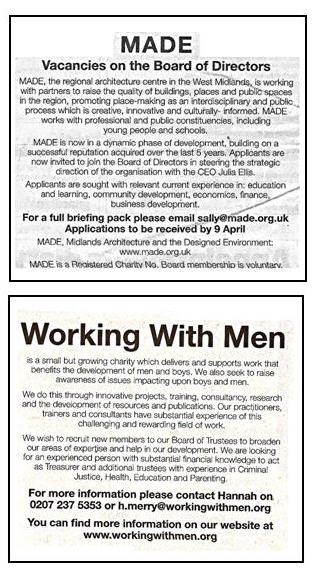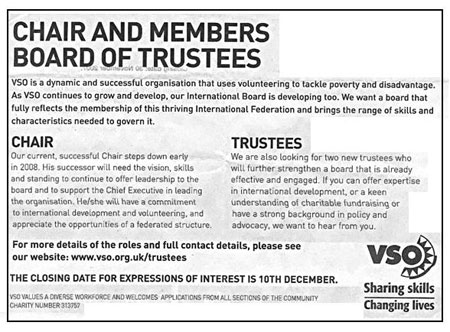Trolling for Leadership
Last year, when working in London, Steve came across the following advertisement in a major English newspaper:

It’s a volunteer recruitment ad, you will note, done in the classic style. It mentions the title of the volunteer position, the qualifications being sought and even the goal of the position, along with logistical contact details. But what makes it a bit different is that it attempts to fill a rather significant position: the Chair of the Board of Trustees of an ambitious international aid effort.
On subsequent trips, Steve collected a few more of these types of volunteer recruitment ads, also found in major newspapers. Click here to see them at the bottom of the page. Also, on the UK job site, guardianjobs, you can browse current volunteer opportunity postings labeled “trustees” for more examples.
If you’re reading this in the United Kingdom, you probably aren’t as shocked as readers in other countries. It has apparently become commonplace in the UK to conduct recruitment for leadership positions by the old-fashioned trolling method.
Not so, however, in the unenlightened rest of the world. In countries outside the UK, we tend to have some very interesting lines of separation between boards of trustees and any other type of volunteer involvement, including whether or not the volunteer program manager has anything whatsoever to do with recruiting board members.
So we thought we’d talk a little about this separation, its implications and what volunteer managers might to do be helpful.
Separate Recruitment of Leadership and Direct Service Volunteers
In smaller or more grassroots organizations, it’s more likely that volunteers who are on the board of directors are also engaged in direct service to clients, and vice versa. As a practical matter, the lines get blurred when everyone has to pitch in to get things done. But as organizations grow, hire paid staff and formalize their operations, the connection between leadership/governance and service volunteering eventually stops. In the United States – and in most other countries – volunteer managers typically have little or nothing to do with the management of the volunteer experience of those who serve on non-profit boards of directors.
Nowhere is this more obvious than when it comes to recruitment of board member volunteers.
A charitable (no pun intended) description of the recruitment process for board members in US non-profits is that it is, at best, accidental. Typically, a small group of board members is constituted as a “nominating committee” that meets briefly to generate the names of possible new members. Usually they have no clear instructions regarding desirable qualities of the candidates; as a result, they usually end up simply offering the names of individuals with whom they are already acquainted (or perhaps with whom the executive director is acquainted). There are few tools for board recruitment (hence Steve’s reaction to the ads in the UK) beyond personal phone calls and arm-twisting over lunch. The whole process frequently results in a board that is inbred, with little diversity.
Ironically, the only paid staff member interacting with the board on a regular basis is most often the executive director, whose main experience in finding and hiring anyone is usually limited to employees. We already know that executives are uneducated in the principles of volunteer management, so why should we expect them intuitively to understand what makes recruitment of high-level volunteers different from finding, say, line managers? It is practically unheard of for a volunteer program manager to be consulted in the board recruitment process, yet who else knows what to do?
In the same vein, the corps of volunteers already serving the organization is rarely perceived as a talent pool for prospective board members. One prejudice that still runs rampant is that volunteers are, by definition, low-level folks with few executive skills and probably no money or contacts. On the other hand, board members (who don’t identify themselves as volunteers much of the time) are seen as a breed apart.
Differences in Screening and Training Volunteers
The separation between board volunteers and direct service volunteers continues beyond recruitment. Governance candidates are asked to serve on the board, but the process does not usually include any information about what they are expected to do, what the nature of their responsibilities will be, or what the board thought they could offer to the organization. Apart from the meeting in which the invitation to serve is offered, there is no real interviewing or screening process, and only rudimentary (if any) orientation and training. This goes a long way to explain why many non-profit boards are ineffective.
In the past 20 years or so – as non-profit boardsmanship has inspired a mini-industry of books, seminars, technical assistance and other forms of support – such poor practice has been universally discredited. Yet the evidence is clear that the expert advice is too often ignored. ronically, while many non-profit board members are enlisted haphazardly on the front lines of the organization’s work, volunteer management has become more and more risk management driven.
Consider the case of volunteers serving in hospitals, one of the bulwarks of volunteering in the United States. Currently, your typical hospital volunteer applicant goes through an intense process in order to demonstrate safety and trustworthiness. These steps are rightly intended to insure that both the volunteer and the patient are protected, and include:
- Background checks for criminal records and health history.
- Training on health safety and hospital practices.
- Immunization for possible diseases
Ever try asking a hospital Director of Volunteer Services about the reaction of their new board members when asked to sit through the required training on HIPPA regulations (a law designed to insure safeguarding of patient information)? Chances are good that she or he won’t even understand the question! Somehow board volunteers are exempt from any of the screening or training requirements of other volunteers.
The majority of non-profit board members begin work with absolutely no orientation or training – and start voting on major decisions affecting the organization despite a somewhat appalling degree of ignorance. (Steve and Susan both testify from personal experience on this one, as two of the ignorant.)
For good or for bad (and mostly for bad), we seem to view leadership volunteers as a distinctly different entity than service volunteers, and the result has been to separate them from the normal volunteer management systems that we have developed to ensure a more effective volunteering system for anyone involved in our organizations.
How Boards Work
Hands-on volunteer management must find methods to successful do the following:
- Keep track of assignments, deadlines, stages of work completed.
- Understand that the commitments of part-time volunteers must be juggled with the demands of their outside lives but also aligned with the full-time demands of the organization.
- Communicate frequently and well with all the people involved in a project.
- Monitor performance.
- Evaluate results.
- Recognize and thank contributors.
- Assure teamwork between employees and volunteers, and among volunteers themselves.
Do you see how these activities resonate equally for what’s necessary for a board to operate smoothly? Unfortunately, too many of the items on this list remain undone when it comes to boards.
Educating Up: Applying Volunteer Management to Leadership Volunteers
We’re going to take it as a given that e-Volunteerism readers “get it” and understand that volunteer management techniques all apply to boards of directors in exactly the same way as they apply to any other type of volunteer. So how are we going to help our administrators see it, too?
The first step is self-assurance. If you do not believe you have a role to play with the board, then how can you expect your executive to think so? If you feel confident that you offer a knowledge-base and experience that are valuable to the board process, you will develop ways to demonstrate why you have to be on the board development team.
The second step is to educate yourself about who is on the board now, when term limits are up, how the nominating process works, etc. Some of this is public knowledge (read the organization’s by-laws!) and some can be gleaned from water cooler talk. Start conversations with managers at ever-ascending levels and ask them what they think of the engagement of the board. You might also conduct a little survey of the make-up of the board, including a chart of board diversity across age, ethnic and cultural categories. All of this is necessary in order to assess whether board management is in good or bad shape, and then develop a plan of action.
Step three is to offer your services to your executive director. You will not necessarily be dealing directly with any of the board volunteers. The important thing is to first assist the head of the agency who, in turn, will then better support the board. What can you offer to do and how can you create direct contact with board volunteers? Here are some ideas:
- Review the position descriptions of board members and officers well before recruitment is done to make sure they are written effectively and include everything necessary to answer a prospective volunteer’s questions, etc. If necessary, do research on what other boards in your type of setting do.
- Provide a report on the volunteers serving in the organization, explaining such important (and perhaps surprising) volunteer facts as:
- University degrees earned by volunteers and other professional education.
- Current and former occupations and employers.
- Current and prior board service in other organizations.
- Direct relationship to the mission (e.g., personal experience with the disease or issue).
- Volunteers who are also financial donors
Offer to recommend three to five possible candidates for the board from the group. (If you do not have this sort of data at your fingertips already, we recommend you start collecting it – for lots of reasons!)
- Describe all the places where you have listed opportunities to volunteer with your organization and select those you feel have the greatest potential to help recruit board members. Do some research on those online (and perhaps local) registries that specialize in board service and report those, too. Offer to help write an “ad” such as those Steve found in the UK.
- Make a list of any screening procedures and background checks required for service volunteers; query whether it is legal or appropriate to exempt board members from such requirements. (It can’t hurt to get people thinking!) If you are in a small non-profit where board members also perform direct service roles, you may find some who have already undergone background checks, orientation and training, and other requirements. These individuals can help you present the concept to the entire board.
- Offer to find ways to get board applicants who do not qualify yet for service on the board to become front line volunteers in other assignments. Make the volunteer program a step in a service career ladder; people committed to the cause can work their way up to greater authority.
- Provide a full description of the orientation program you’ve created for service volunteers and describe how this might be offered to new board members or adapted to their needs. Offer to give a tour of the facility to newcomers (and maybe even veteran board members will welcome that). If you have any handouts or slide shows or other informative materials, make these materials available to board members, too.
- Offer to find tasks that a board member could do if she or he were asked to spend a few hours once or twice a year observing and participating in the work of the agency. In other words, show how occasional service volunteering can be great experiential learning. How can board members govern an organization they have never seen operate?
- Include board members in your informal and formal volunteer recognition. Advise the executive to do something nice or fun for the board once in a while. Make sure they receive whatever annual volunteer recognition gifts or certificates that any other volunteer gets. Find as many ways as possible to say thank you throughout the year.
- Really make the most of any formal recognition event. Invite members of the board to attend, but do not allow them to be treated like visiting royalty, “above” the other volunteers. In fact, go out of your way to make all the volunteers equal for those few hours. Mingle board members at tables with other volunteers. Do interactive things that allow them to hear the stories of why service volunteers care so much – and to have a chance to share why they care, too.
- Design a time/activity report for board work and collect the data on what board members do, especially on committees and in-between meetings. Include this information in reports on community contributions to the agency.
You may be thinking: How in the world can I just start doing all of this? I am not even allowed to communicate with board members nor do I meet regularly with my executive director.
You will not be able to implement everything all at once, of course. Pick one or two things that you feel you can offer first and write out a plan. Attach a copy of this article, if you wish – it could be a discussion starter. No one was ever fired for initiative! And if you are rejected, you have an opening to discuss why. And then pick something smaller and try again.
Conclusion: Back to Board Recruitment
We know that much of what we’ve written above will seem strange, and may certainly be a challenge. Like all large tasks, however, you need to start somewhere, and focusing on recruitment may provide an opportunity.
Ultimately, however, systems are no better than the people who are in them, and this applies to volunteer-involving organizations as well as others. For too long we have allowed the selection of board member volunteers to be a haphazard and limited process, while at the same time the recruitment of service volunteers has become more and more sophisticated. This is bad management of a sort that we simply cannot allow to continue. The more you examine the ads from the United Kingdom, the more you realize that this approach to recruiting new board members will, in fact, result in a more dedicated and more diverse cadre of leadership volunteers.
Volunteer managers have the capacity to help their organizations dramatically improve the capacity of the most important volunteers they have – those who provide the vision, leadership and skills required to guide and support the future.
Ads for the "Chair of the Board of Trustees" position






Previously posted comments
Tue, 08/17/2010Posted on 22 April 2008 by Martha J. Martin, M&M Consulting,
White Lake MI
Thanks for writing about an issue that is consistently ignored in agencies. May take some courage for managers of service volunteers to move into the area where board members are recognized as volunteers and entitled to management techniqes utilized with program volunteers.Sitiing in an all day retreat in which board members talk about volunteers as if they were a different breed is frustrating. Bylaws do not truly define a position description. My experience with board orientations are they are either non-existent or boring. Hope that the attention to this article will lead to new management directions for board members in agencies.